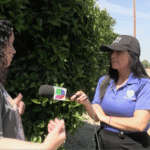Breeder: Edward Cannon
Business name: East Cannon Kennels
Address: 15212 Bootjack Trail
City, State Zip: Novinger, MO 63559
Year: 2015
USDA License: 43-A-4206
Date of CAPS Investigation: 04/20/15; 04/21/15
Time of CAPS Investigation: 1:14pm; 11:43am
Weather at time of investigation: April 20, 2015: 53 degrees Fahrenheit and mostly cloudy; April 21, 2015: 60 degrees Fahrenheit and sunny
Breeds: Pomeranians, Yorkshire Terriers, Maltese, Poodles, Bichons, Boston Terriers, Lhasa Apsos
Approximate number of dogs observed at time of investigation: 160 dogs (not all buildings were observed; no access was available to whelping barns or to cat buildings)
When I visited the property on April 20, 2015, there was no one present to allow me access to the kennel; however, there were several workers on the property. Edward Cannon was there on April 21, 2015.
I observed dog enclosures, but no cat enclosures, at the facility. There were four rows of elevated cages within about 40’ and just north of Cannon’s house; these were treated-wire cages, with four cages per bank and four banks of cages in the area. Each cage held three to four small-breed dogs.
I also observed dog enclosures northeast of Cannon’s house, where there were about nine buildings. Three of these buildings contained Sundowner-type, stacked indoor/outdoor cages. The Sundowner cages, of typical design, were converted to have slatted plastic flooring. Mr. Cannon said that he had recently made the changes to comply with Proposition B requirements. There were four to eight cages per row, two rows per side, on each of two sides of the Sundowner barns. Plastic sheeting and wooden beams framed and elevated the cages, which were about two feet wide, two feet high, and three feet long. The outdoor sections had plastic sheets that covered about two feet of the cage wall, allowing the dogs to see through one foot of wire-wall. Metal doggie doors allowed access to indoor enclosures. Each cage held two to three dogs of various small breeds.
I saw that the northernmost barn on the property housed various whelping mothers and puppies in stacked, treated-wire cages, but I did not enter that barn or any others. The three buildings with outdoor, stacked cages had metal walls on their eastern sides to prevent viewing them from the road; the metal walls also prevented dogs in those cages from seeing virtually anything outside of their cages. The dogs were able to step out of their inside cages, through a doggie door, into the outdoor cage with a metal wall covering the entire height and length of the eastern side of their cage bank. An open area about two feet wide and two feet long for the outside top and bottom cages allowed the dogs in those cages to see to the north and south if they stepped to the far ends of the cage. It should be noted that limiting a dog’s stimulation and enrichment by confining it so that it cannot see anything beyond its enclosure is not a violation of the federal Animal Welfare Act; however, such housing is a Missouri state violation (2 CSR 30-9.030 (1) Facilities and Operating Standards (F) Primary enclosures 3. C. (2) (B) Exercise for dogs 4. Constant and unfettered access).




